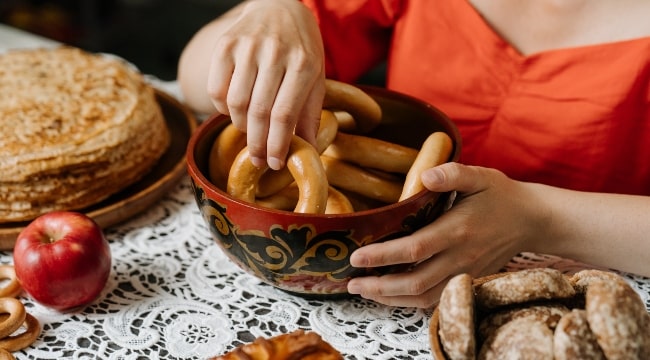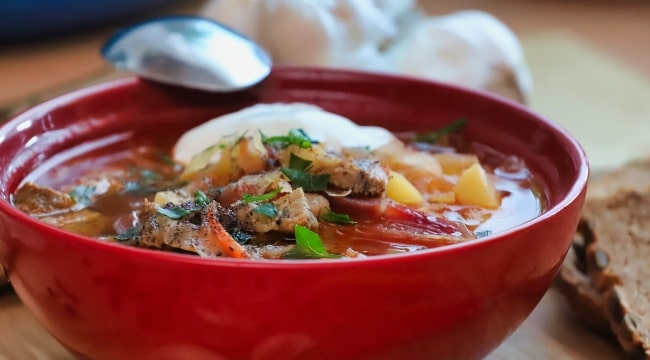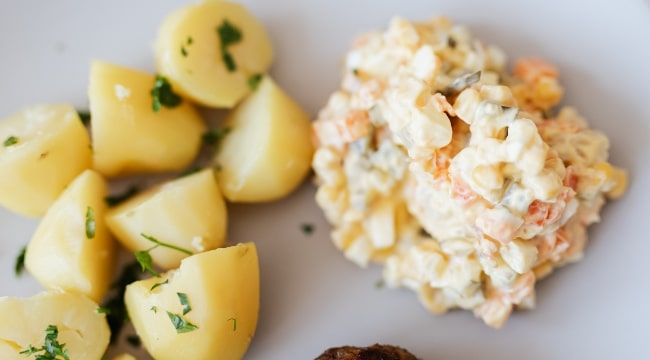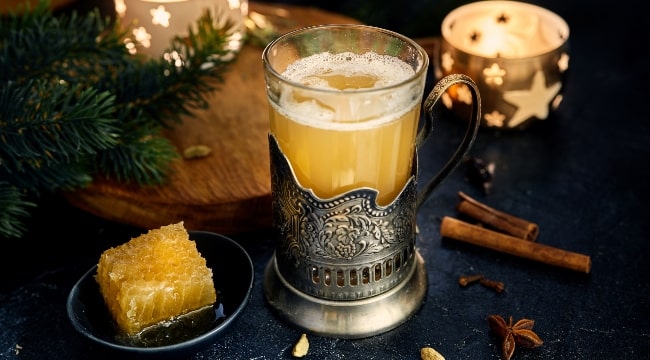Russian food may seem strange and foreign, but the familiarity of its ingredients may shock you. One of the most common components of dishes in Russia is one of America's favorite garnishes: sour cream.
It is used as a dip or condiment in America, in Russia, it is baked into cakes and put in a soup. This is but one example of the bridge connecting two seemingly distant cuisines.
Staple Russian Food
Just as America is famous for being a country of pizza lovers and hot dog connoisseurs, Russia also identifies with a number of national dishes. Contemporary Russian cuisine is truly delicious. It is also healthy because it mostly relies on naturally grown ingredients. It is also very filling because Russian dishes have tons of vegetable oil, sour cream, and mayo. Russian national cuisine uses lots of grains and roots, vegetables, and everything else that vast lands, rich woods, and a plentiful of lakes and rivers have to offer. Staple Russian food features lots of fish, mushrooms, and berries.
Because of the harsh climate, Russians had a limited variety of ingredients, but this hardship has been compensated with creative recipes and combinations, as they have invented a mind-boggling variety of soups and because they had to preserve food for cold winters, Russians made a science out of pickling vegetables.

Among the most important ingredients in Russian cuisine are potatoes. In the early 18th century Peter the Great brought potatoes to Russia (they had been discovered in South America).
At first, they were available to only elites and were considered poisonous by the peasants. Over time, potatoes have become the central element in almost every Russian dish, fried, boiled, baked, mashed, cooked as cakes, and so forth.
Later, with the development of Russia and expansion of its territories to Western Europe during the 16th-18th, Russian kitchens of aristocrats incorporated the most sophisticated recipes from Austria, Germany, and France to their meals.
Contemporary Russian Food
Russian breakfasts are very similar to those in some western countries. For breakfast, Russians almost always drink tea with a sandwich with meat (kolbasa), or fried eggs or omelets (but without bacon). Sometimes they make blini. Lunch always features soups and Russian dinners are similar to any Western cuisine, featuring a variety of fried meats and fish.

Meals are served with rich salads (the recipe of the most popular salad is very simple: cucumbers + tomatoes +onions + sour cream/mayo), picketed vegetables, and boiled of fried potatoes. Some dishes are more creative than others and take a while to make like golbuci - ground beef with rice wrapped in cabbage leaves and stewed in an oven for 3 hours.
Popular Russian Food: Blini, Pelmeni, Borsch & Salads
Блины or blini
The French have their crepes, the Americans have their pancakes, and the Russians have their blinis.
A blin is a very thin circle of batter cooked the same as pancakes.

Blinis are used to hold hot food and depending on personal preferences can be filled with anything to accommodate every unique taste.
Fill it with fruit, jam, honey, jelly, or cottage cheese to make a terrific dessert; roll chicken, meat, salad, or fish into blini for a nourishing dinner, and for special events use caviar as a filling.
Пельмени or Pelmeni
Pelmeni translates literally to "ear-shaped dish". It is very similar to ravioli. Tiny pockets of cooked dough, pelmenis are usually filled with seasoned meat.

They are simple to cook and easy to eat and are most delicious with melted butter and sour cream.
Суп or Soup
Russians love soups! Borsch, fish soup, cabbage soup – the possibilities are endless. Traditionally eaten at the start of a meal, soups are believed to aid in the digestive process.
Russians have a mind-boggling variety of soups: rassolnik - chicken soup with pickles, salanka - meat soup with olives and sausages, okroshka - a cold soup made of chopped vegetables, orange borsh - cabbage soup, soup s frikadlkami - meatball soup, uha - fish soup and the list goes on.
There is one secret that makes Russian soups so good - podjarka - which is a pre-frying of chopped onions, grated carrots, and a little bit of garlic in vegetable oil. When carrots take on a golden hue and onions become transparent "podjarka" is added to the soup.

Borsch beet soup is by far the most popular. Its recipe differs from family to family, providing an array of tastes based on region.
Common borsch ingredients are beets, potatoes, cabbage, carrots, meat, and a variety of spices.
Its finishing touch is sour cream, and though hot sour cream may seem too bizarre, it melts into the soup and adds a creamy, tart twist to the savory dish.
Салаты or Salads
Russian salads are not the usual lettuce-and-dressing, they are more reminiscent of American potato or chicken salad. Composed of many different chopped ingredients, they are held together by a good helping of mayonnaise.

Sometimes the ingredients are quite simple, like mayo, ham, and cheese salad, and sometimes they are packed with every vegetable within reach – carrots, garlic, peas, pickles, cabbage. Though the way Russians use their ingredients may seem elaborate you are almost guaranteed to leave Russia a few pounds heavier than you arrived.
Напитки or Beverages
While Russians are most famous for vodka, there are a number of other delicious national drinks as well. Aside from alcoholic beverages, many Russians drink tea, coffee, and a variety of juice.

They also produce a beverage called Kvas, a drink made from fermented bread. Another delicious traditional Russian drink is mors (juice of boiled berries. And, of course, the Russian tea ceremony with a samovar is a must-experience.
Десерты or Desserts
As for sweets, Russia is not without its fair share of sugary wonders. The most popular gifts given during the holidays are chocolates, cakes, and pastries.

Stores devote entire aisles to chocolate, providing different flavors, forms, fillings, and more. Belgium may be famous for producing chocolate, but Russia is where chocolate is appreciated.
Must-Taste Russian Food:
- Blini with fruits, jam, honey, or cheese
- Pelmeni with sour cream
- Borsch soup or salanka
- Russian Salad
- Kvas drink or other
- Medovik (honey cake) or Bird’s milk cake
Interesting Russian Food
Russia is not without its unusual cuisine. Two of its most unique foods are salo – pig fat – and cow's tongue. Eating them requires a strong stomach, but many Russians consider these dishes to be delicacies.

Another weird Russian dish is stooden also called kholodetc. Its name derived from the word "kholod" meaning cold, and in America, the dish is known as aspic. It is a gel made by letting cooked meat with garlic and other key ingredients sit in a refrigerator until the broth hardens into a gel. It is then taken out and eaten cold. Meat Jell-O! Cooking it is a laborious task as it takes long hours to boil and cool the jellied minced meat dish. It is also considered "Vodka's best friend" kholodetc is often served with cold vodka and eaten with spicy horseradish mustard sauce.
You'll also find an array of berries that aren't widely eaten in America, and if you are in rural Russia during the right season, you can pluck them right off the bushes! The most surprising list may be the collection of things Russians DON'T eat. You will rarely see a Russian eating peanut butter, apple sauce, cheddar cheese, American-style sandwiches, Mexican food, or many Italian dishes. Get used to mayo-salads and borsch!
What is Kholodetc?
It is a gel made by letting cooked meat with garlic and other key ingredients sit in a refrigerator until the broth hardens into a gel.
Changing Habits - Eating Out
Russians are not accustomed to eating out. Until recently, many could not afford to do so, but the times are changing and today, it is much more common for the city dwellers to dine in restaurants not just on holidays, but on typical days as well. Even though there are many ethnic places to eat, most restaurants cater to traditional Russian food described above. The available restaurants, though, will not disappoint. Russia is full of cafes, fast food restaurants, dine-in restaurants, and cafeteria-style locations.

If you want a quick snack during your Russian tour, there are stands all over the main cities that serve the savory and sweet doughy goodness of blinis. If none of these options suit you, American restaurants are popular in every city, from Sbarro and Pizza Hut to Subway and McDonald's. What is more, many Moscow restaurants and restaurants in St. Petersburg are renown worldwide and are worth a visit.
One of the best ways to taste Russian cuisine is during large holidays such as birthdays or New Year's Eve. Whether you are being adventurous with kholodets or enjoying a pot of borsch, you are guaranteed to find something that will fill you, your heart, and soul.
